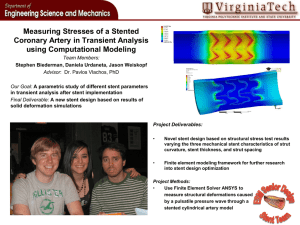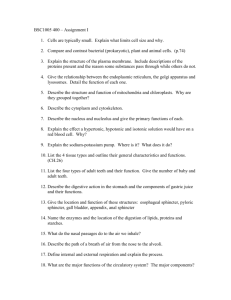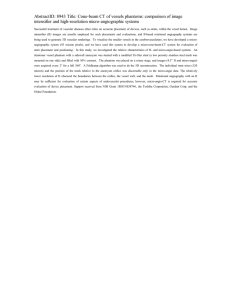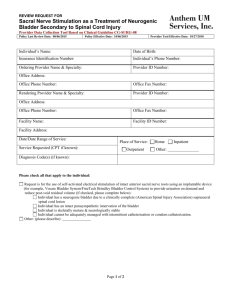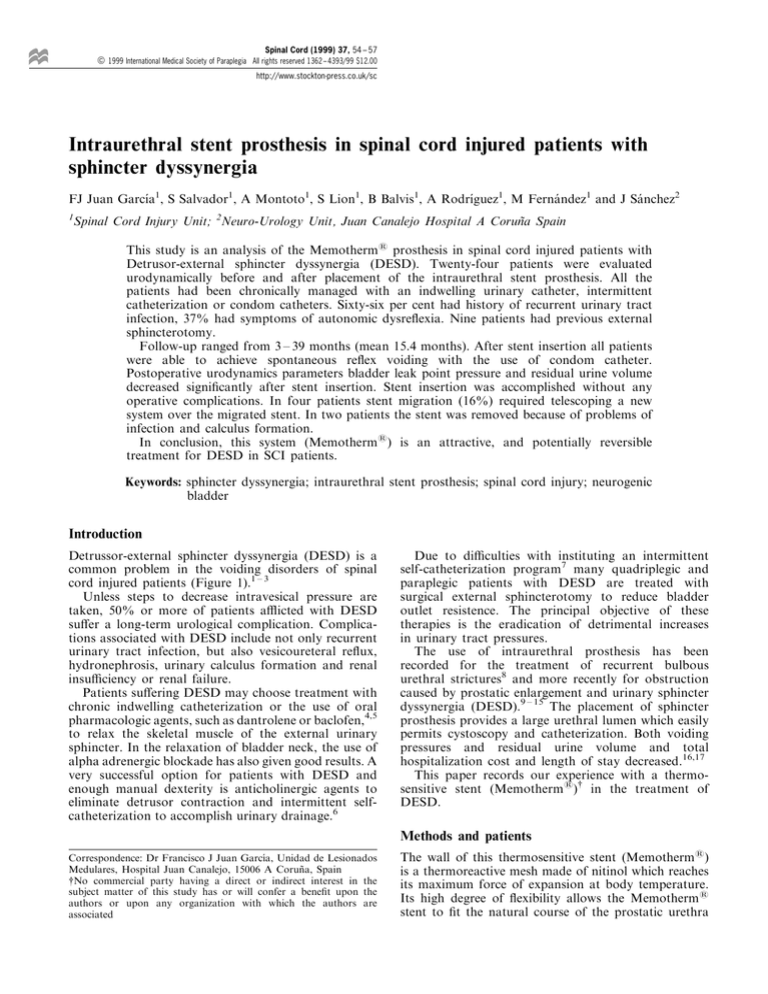
ã
Spinal Cord (1999) 37, 54 ± 57
1999 International Medical Society of Paraplegia All rights reserved 1362 ± 4393/99 $12.00
http://www.stockton-press.co.uk/sc
Intraurethral stent prosthesis in spinal cord injured patients with
sphincter dyssynergia
FJ Juan GarcõÂ a1, S Salvador1, A Montoto1, S Lion1, B Balvis1, A RodrõÂ guez1, M FernaÂndez1 and J SaÂnchez2
1
Spinal Cord Injury Unit; 2Neuro-Urology Unit, Juan Canalejo Hospital A CorunÄa Spain
This study is an analysis of the Memotherm1 prosthesis in spinal cord injured patients with
Detrusor-external sphincter dyssynergia (DESD). Twenty-four patients were evaluated
urodynamically before and after placement of the intraurethral stent prosthesis. All the
patients had been chronically managed with an indwelling urinary catheter, intermittent
catheterization or condom catheters. Sixty-six per cent had history of recurrent urinary tract
infection, 37% had symptoms of autonomic dysre¯exia. Nine patients had previous external
sphincterotomy.
Follow-up ranged from 3 ± 39 months (mean 15.4 months). After stent insertion all patients
were able to achieve spontaneous re¯ex voiding with the use of condom catheter.
Postoperative urodynamics parameters bladder leak point pressure and residual urine volume
decreased signi®cantly after stent insertion. Stent insertion was accomplished without any
operative complications. In four patients stent migration (16%) required telescoping a new
system over the migrated stent. In two patients the stent was removed because of problems of
infection and calculus formation.
In conclusion, this system (Memotherm1) is an attractive, and potentially reversible
treatment for DESD in SCI patients.
Keywords: sphincter dyssynergia; intraurethral stent prosthesis; spinal cord injury; neurogenic
bladder
Introduction
Detrussor-external sphincter dyssynergia (DESD) is a
common problem in the voiding disorders of spinal
cord injured patients (Figure 1).1 ± 3
Unless steps to decrease intravesical pressure are
taken, 50% or more of patients aicted with DESD
suer a long-term urological complication. Complications associated with DESD include not only recurrent
urinary tract infection, but also vesicoureteral re¯ux,
hydronephrosis, urinary calculus formation and renal
insuciency or renal failure.
Patients suering DESD may choose treatment with
chronic indwelling catheterization or the use of oral
pharmacologic agents, such as dantrolene or baclofen,4,5
to relax the skeletal muscle of the external urinary
sphincter. In the relaxation of bladder neck, the use of
alpha adrenergic blockade has also given good results. A
very successful option for patients with DESD and
enough manual dexterity is anticholinergic agents to
eliminate detrusor contraction and intermittent selfcatheterization to accomplish urinary drainage.6
Due to diculties with instituting an intermittent
self-catheterization program7 many quadriplegic and
paraplegic patients with DESD are treated with
surgical external sphincterotomy to reduce bladder
outlet resistence. The principal objective of these
therapies is the eradication of detrimental increases
in urinary tract pressures.
The use of intraurethral prosthesis has been
recorded for the treatment of recurrent bulbous
urethral strictures8 and more recently for obstruction
caused by prostatic enlargement and urinary sphincter
dyssynergia (DESD).9 ± 15 The placement of sphincter
prosthesis provides a large urethral lumen which easily
permits cystoscopy and catheterization. Both voiding
pressures and residual urine volume and total
hospitalization cost and length of stay decreased.16,17
This paper records our experience with a thermosensitive stent (Memotherm1){ in the treatment of
DESD.
Methods and patients
Correspondence: Dr Francisco J Juan GarcõÂ a, Unidad de Lesionados
Medulares, Hospital Juan Canalejo, 15006 A CorunÄa, Spain
{No commercial party having a direct or indirect interest in the
subject matter of this study has or will confer a bene®t upon the
authors or upon any organization with which the authors are
associated
The wall of this thermosensitive stent (Memotherm1)
is a thermoreactive mesh made of nitinol which reaches
its maximum force of expansion at body temperature.
Its high degree of ¯exibility allows the Memotherm1
stent to ®t the natural course of the prostatic urethra
Intraurethral prosthesis and sphincter dyssynergia
FJ Juan GarcõÂa et al
55
(Figure 2). This stent is available in dierent sizes
between 2 ± 8 cm and dierent diameters (36 ± 42 ch) to
meet the demand for dierent lengths of prostatic
urethra. Furthermore, the meshed structure allows its
atraumatic removal.
Twenty-four consecutive patients with detrussorexternal sphincter dyssinergia (DESD) and spinal cord
injury (SCI) were evaluated, from May 1993 to July
1996. Eighteen patients had a cervical spinal cord
injury. Urodynamic evaluation was performed before
and after the insertion of the stent con®rming
Figure 1 Hypertonia of the external sphincter
detrussor-external sphincter dyssynergia (DESD) in
all patients by EMG and pre-stent re¯ex detrussor
contractions voiding pressure 460 cm H2O. The
bladder leak point pressure also was determined in
urodynamic evaluation (de®ned as the maximum
vesical pressure required to overcome bladder outlet
resistance, resulting in passage of urine beyond the
bladder outlet).
These patients had been chronically prescribed an
indwelling urinary catheter or used intermittent
catheterization. Some patients were diagnosed with
simultaneous concomitant bladder neck or prostatic
urethral obstructions.
Prosthesis insertion technique was performed in all
patients by the same physician (Dr SaÂnchez) using a
specialized stent deployment device with an optical
system. The device is simultaneously withdrawn and
the stent is gradually released, in its ®nal position
from verum montanum to external sphincter. It is
important that the distal end of the prosthesis should
be in the bulbous urethral at least 5 mm beyond the
end of the external sphincter. Prophylactic antibiotics
are initiated preoperatively and continued for at least
2 weeks. Due to its shape memory (the stent is
expandable with dierent temperatures), if the
prosthesis is not properly placed it may be displaced
or removed endoscopically, using cold or hot
solutions to alter thermoreactive capacity. The
thermoreactive feature of stent is what makes this
stent unique.
Figure 2 Intraurethral stent prosthesis has just been placed in the external sphincter
Intraurethral prosthesis and sphincter dyssynergia
FJ Juan GarcõÂa et al
56
Results
Follow-up ranged from 3 ± 39 months (mean 15.4
months). The longest follow-up period was 42 months.
Preoperative complications
Preoperatively, 17 patients had a history of symptomatic urinary tract infections (70%), eight patients had
symptoms of autonomic dysre¯exia (33%), seven
patients had developed vesicoureteral re¯ux, two
patients bladder calculi, two bulbous urethral strictures, nine patients had previous external sphincterotomy and three patients benign prostatic hyperplasia.
These patients were preoperatively managed with
dierent methods. Thirteen patients had been managed
with indwelling catheter, ®ve patients with sucient
manual dexterity by using intermittent catheterization
and six patients were managed with condom catheter.
After stent insertion all patients were able to achieve
spontaneous re¯ex voiding with the use of condom
catheter. No patients needed intermittent catheterization. Five patients needed, after insertion, oral
pharmacologic alpha adrenergic blockade in order to
open the internal sphincter or avoid autonomic
dysre¯exia. The prosthesis itself did not aggravate
autonomic dysre¯exia post-insertion (8%). The incidence of symptomatic urinary tract infection after
insertion decreased: ®ve patients (22%). In the 18
patients with the stent properly placed, preoperative
and postoperative urodynamics parameters bladder
leak point pressure and residual urine volume
decreased signi®cantly after stent insertion (Table 1).
The postoperative urodynamic study was performed 6
months after insertion.
Stent insertion was achieved without any operative
problem and complications with the system. Complications after insertion were limited to: six patients with
bleeding not requiring treatment, one intra-operative
sepsis, four patients with early stent migration
(displacement or migration in the ®rst 24 h) which
required telescoping a new system over the migrated
stent (16% of stent migration), one case of obstructive
neoepithelial growth which had to be removed, and
one stent had to be removed because infection and
calculus formation.
Discussion
Common complications attributed to indwelling catheter are: infection, squamous cell metaplasia, urethral
Table 1 Values of mean bladder leak point pressure
Mean bladder leak point pressure
(cm H2O)
Preoperative
Postoperative
93.7 (range 60 ± 130)
35 (range (5 ± 75)
diverticules or ®stula, urethral stricture and bladder
calculi and predispostion to bladder cancer.18 ± 22
Consequently most spinal cord units attempt to render
patients free of indwelling catheters. The complications
associated with external sphincterotomy eg reoperation
rate 12 ± 26%, erectile dysfunction, irreversible nature,
blood transfusion or sepsis have encouraged the
development of a potentially reversible treatment:
sphincter stent.
The advantage of this prosthesis is its large lumenal
diameter which allows for the catheterization and
cystoscopy after epithelization. Sphincter prosthesis
placement reduces signi®cantly voiding pressure and
residual urine volume without adverse eect on
bladder capacity.23 In our clinical experience many
SCI patients with DESD prefer the stent because it is
potentially reversible. Renal and erectile function were
not negatively altered after prosthesis and hydronephrosis may be resolved or stabilized in all patients.
We feel that it is essential for patients considering
sphincter procedures to experience and to accept
condom catheter before stent. Serial urodynamics
evaluation after stent placement is necessary to avoid
the possibility of bladder neck obstruction.
In conclusion the memotherm1 stent is an
attractive, potentially reversible treatment option for
DESD in men with an indwelling catheter including
those on whom an external sphincterotomy has been
performed previously.
References
1 McGuire EJ, Brady S. Detrusor-sphincter dyssynergia. J Urol
1979; 121: 774 ± 777.
2 Kaplan SA, Chancellor MB, Blaivas JG. Bladder and sphincter
behavior in patients with spinal cord lesions. J Urol 1991; 146:
113 ± 117.
3 Yalla SV et al. Detrusor-urethral sphincter dyssynergia. J Urol
1997; 118: 1026 ± 1029.
4 Hachen HJ, Krucker V. Clinical and laboratory assessment of the
ecacy of baclofen (Lioresal) on urethral sphincter spasticity in
patients with traumatic paraplegia. Europ Urol 1980; 3: 237 ± 240.
5 Hackler RH, Broecker BH, Klein FA, Brady SM. A clinical
experience with dantrolene sodium for external urinary sphincter
hypertonicity in spinal cord injured patients. J Urol 1980; 124:
78 ± 81.
6 Lapides J, Diokno AC, Silber SJ, Lowe BS. Clean intermittent
self-catheterization in the treatment of urinary tract disease. J
Urol 1972; 107: 458 ± 461.
7 Bunts RC. Management of urological complications in 1000
paraplegics. J Urol 1958; 79: 733 ± 741.
8 Donald JJ, Rickards D, Milroy EJ. Stricture disease: radiology of
urethral stents. Radiol 1991; 180: 447 ± 450.
9 Shaw PJ et al. Permanent external striated sphincter stents in
patients with spinal injuries. Br J Urol 1990; 66: 297 ± 302.
10 Dobben RL et al. Prostatic urethra dilatation with the Gianturco
self-expanding metallic stent: a feasibility study in cadaver
specimens and dogs. Am J Roentgenol 1991; 156(4): 757 ± 761.
11 McInerney PD, Vanner TF, Harris SA, Stephenson TP.
Permanent urethral stents for detrusor sphincter dyssynergia.
Br J Urol 1991; 67: 291 ± 294.
12 Chancellor MB, Karasick S, Erhard MJ, et al. Placement of a
wire mesh prosthesis in the external urinary sphincter of men with
spinal cord injuries. Radiol 1993; 187: 551 ± 555.
Intraurethral prosthesis and sphincter dyssynergia
FJ Juan GarcõÂa et al
57
13 Milroy EJ et al. A new treatment for urethral strictures. Lancet
1988; 1: 1424 ± 1427.
14 Williams G, White R. Experience with the memotherm
permanently implanted prostatic stent. Br J Urol 1995; 76:
337 ± 340.
15 Ricciotti G et al. Heat-expansible permanent intraurethral stents
for benign prostatic hyperplasia and urethral strictures J
Endoural 1995; 9: 417 ± 422.
16 Chancellor MB et al. Multicenter trial in North America of
UroLume2 urinary sphincter prosthesis. J Urol 1994; 152: 924 ±
930.
17 Chancellor MB et al. Prospective comparison of external
sphincter balloon dilatation and prosthesis placement with
external sphincterotomy in spinal cord injured men. Arch Phys
Med Rehabil 1994; 75: 297 ± 305.
18 Stover SL, Lloyd K, Waites KB, Jackson AB. Urinary tract
infection in spinal cord injury. Arch Phys Med Rehabil 1989; 70:
47 ± 54.
19 De Vivo MJ, Fine PR, Cutter GR, Maetz HM. The risk of
bladder calculi in patients with spinal cord injuries. Arch Int Med
1985; 145: 428 ± 432.
20 Hall MK, Hackler RH, Zampiri TA, Zampiri JB. Renal calculi in
spinal cord injured patients: association with re¯ux, bladder
stones, and foley catheter drainage. Urol 1989; 34: 126 ± 128.
21 Broecker BH, Klein FA, Hackler RH. Cancer of the bladder in
spinal cord injuried patients. J Urol 1981; 125: 196 ± 197.
22 Esrig D, McEvoy K, Bennet CJ. Bladder cancer in the spinal cord
injured patient with long-term catheterization: a casual relationship? Sem Urolg 1992; 10: 102 ± 108.
23 Chancellor MB et al. Management of sphincter dyssynergia using
the sphincter stent prosthesis in chronically catheterized SCI
men. J Spinal Cord Med; 1995; 18: 88 ± 94.

